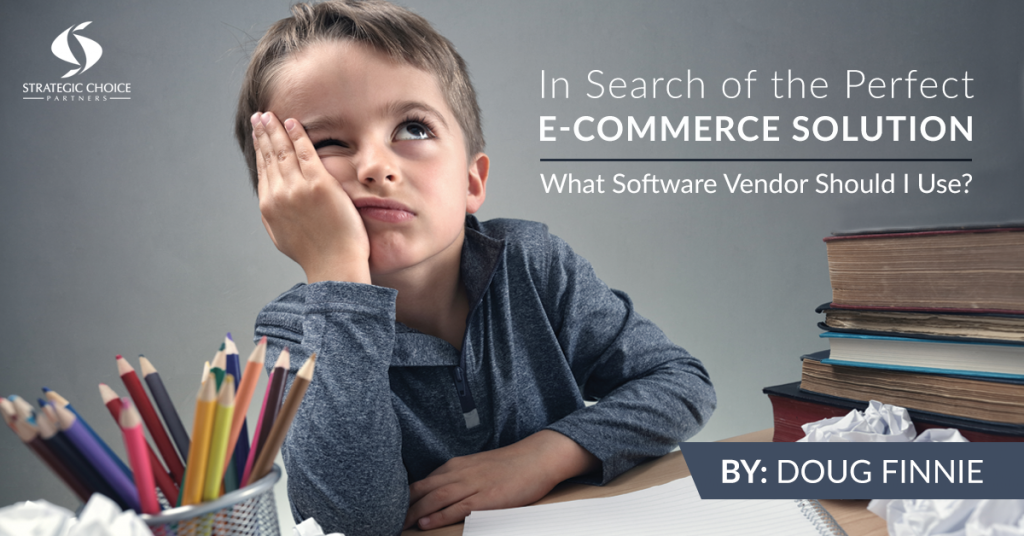 This article is part of an ongoing series by Doug Finnie, titled “In Search of the Perfect E-Commerce Solution.” View the rest of the series HERE.
This article is part of an ongoing series by Doug Finnie, titled “In Search of the Perfect E-Commerce Solution.” View the rest of the series HERE.
E-commerce software comes in many shapes, sizes and costs. The type of solution you pursue will depend on your internal resources. If you have little to no internal IT staff, then you want to seek out highly configurable solutions that non-IT personnel can manage. If you do have internal technical staff, then you can also include extensible or integrated type solutions.
In previous blogs, we described how best to determine which vendor solutions you should pursue. Let’s assume you have done your homework and narrowed your search down to two or three providers. Now you can begin to perform more detailed due diligence on the possible vendors that could eventually be your partner.
Below are factors to consider in your due diligence process:
- Demonstration of System Capabilities
- Functionality
- Ongoing Stability/ Experience of the Company
- References
- Contract Phase
- Master Agreement
- Statement of Work
- Service Level Agreements
- Business Continuity Capabilities
- Project & Implementation Management Process
- Requirements Process
- Development Process
- Testing & QA Process
- Launch Process
- Stabilizing Process
Demonstration of System Capabilities
Beginning with system functionality and industry experience; you will want to set up an initial meeting with the vendor (this can be via video conference). The objective of the first meeting should be to confirm the software meets your high-level business needs. You are not looking to make a decision on this first call. Their demonstration should address the order entry, processing, enrollment, back office and commissions and genealogy features as well as system architecture. How it is licensed and what their standard deployment model looks like should also be explained.
After completing the initial call, ensure you have enough information to narrow your selection down to the top two vendors. Now you will want to have a face-to-face meeting. Your functional managers should be invited to the meeting and have the opportunity to ask probing questions specific to how the system will meet their needs. If this is the first time you have gone through a software vetting process, we recommend seeking outside expertise, such as Strategic Choice Partners, to help guide you through the selection process. Understandably, it can become very overwhelming to determine the right functionality and partner to meet your needs.
The Second Meeting
The face-to-face meeting needs to include probing questions focused on task level functionality. It is critical that you understand the answers you receive. For example, knowing the difference between what a system ‘can’ do and what a system ‘does’ do. As you review functionality, ask ‘does’ the system perform certain functionality, and if the answer is yes, then ask to see it in a live production environment.
References
Besides functionality, expertise in the industry is a must. The direct sales industry is often misunderstood, especially the complexity of the technology to support the business. Having a vendor who understands software and the direct sales industry is a must. Experience is the third point in due diligence. Understanding the vendor’s customer base, relationships and customer satisfaction. Do they have other customers in your specific business line? If so, does their system meet the business’ requirements? Be sure to ask for references and call them. In addition to the references you are provided, be sure to look on the vendor’s site and see if they have a list of customers. If customers are listed that were not on the reference list, call them as well. Sometimes they can provide the best-unfiltered feedback.
Equally important as above is the business stability of the software company. How fiscally sound are they? Do they have a high demand for business? Are there major changes expected (such as a merger pending, selling the company)? What has been the employee rate of turnover? Often times companies with high turnover struggle to deliver a project on time. It is very important to make sure the company that will potentially handle your business revenue stream will be there for you when you need them.
Contract Phase
Next, we will discuss contracts, statements of work and service level agreements. Ensure you obtain an attorney and seek legal guidance for this area. Software contracts can be quite lengthy and difficult to understand. It is important to understand your rights versus the vendor’s rights because it is this document that outlines them. Understand that the software vendor’s intellectual property is one of the most guarded assets they have, and this document is where they will protect that asset. Vendors often protect the ability to use your ideas and processes to enhance their software and resell the enhanced software without you having rights to the enhanced software. You typically see this in a subscription type model.
Statement of Work
A Statement of Work or SOW describes the task that has to be delivered. These documents outline deliverables and costs. They are often included as appendices to the Master Services Agreement. It is important to understand that the SOW is NOT the master agreement, but a supplement to the agreement. Companies often make the mistake of asking for tasks to be in the Master Services Agreement. SOW’s should have milestone plans, dates and costs clearly defined. These documents are used to manage the implementation project tasks and expectations.
Service Level Agreement
Another critical document in the due diligence process is the Service Level Agreement or SLA. This document defines the acceptable levels of operation and maintenance you will accept. This is where you define the ‘uptime’ or how long each period you will allow a system to be offline. The document will also contain maintenance expectations, escalation processed, defining the level of severity for certain issues and penalties that can be assessed against the vendor for failure to perform. As you negotiate this document, it is critical you have someone assist that fully understands how IT organizations work and what minimum performance requirements are acceptable.
Negotiating with a company about service levels allows you to learn a tremendous amount about the vendor. Things like: Are reasonable needs accommodated? Are they hesitant to put performance metrics in the document or discuss penalties? If they are, that should be a red flag towards their confidence in their system and its stability. You should seek legal counsel and industry expertise to assist you in negotiating these terms if this part of due diligence is new to you.
Escrow Agreement
Another critical area in your assessment is the “Escrow Agreement.” This agreement outlines how the vendor will handle the software code that you are using to ensure you have access to it if there is an ‘event’ that would result in the code being at risk. For example, if the company goes bankrupt, decides to go out of business, merges with another company or is bought out. Each of these types of events can result in the code being compromised. You will want to seek legal counsel in creating this agreement and consider seeking outside expertise that can assist in defining and negotiating an escrow clause. In considering what type of escrow account you need, you will want to weigh the cost versus the benefit as agreements can range from a few thousand dollars a year to hundreds of thousands up to millions of dollars to build and maintain.
Project & Implementation Management Process
Continuing the due diligence process, you need to focus on project management and implementation processes. Project Implementation is a full blog of its own, so we will not go into great detail about what’s involved at the task level, but we will cover some high points for you to consider. Beginning with tools and processes such as: project portals; how the project team is structured and measures performance; timelines and milestones; how are risks defined and managed and mitigated; defining and managing customizations to ensure both parties understand scope and scope creep. Also consider the software development life cycle process including software development, testing and release into production.
Interaction Between Personnel
Finally, you want to assess the interaction between your team and the vendor’s team. Be aware of how people interact during the meeting, often times you can trust your first instinct about people and that is important. The communication and relationship building between your organization and the vendor’s project team will be most critical during this time. The goal is to ensure the relationship between these teams is as strong as it can be to ensure continuity throughout the project.
Following the steps above will not guarantee you a perfect vendor nor will it guarantee you a perfect software launch project, but it can reduce the risks in the software acquisition process. Don’t get discouraged as you continue your adventure, it can be daunting at times, but if you follow the steps listed above, it will significantly mitigate the risks and bumps on the road.
About Doug Finnie
 Doug has over thirty years of management experience in the Technology, Direct Sales and Banking industries holding roles in direct sales organizations such as Origami Owl and Gold Canyon Candles and in other industries such as software development and fulfillment and logistics. As an accomplished CIO his specialties include working with business leaders in defining technology strategies, technical contract and due diligence assessments, project management and systems implementation and migrations. Doug has previously served on the DSA Technology Advisory Council.
Doug has over thirty years of management experience in the Technology, Direct Sales and Banking industries holding roles in direct sales organizations such as Origami Owl and Gold Canyon Candles and in other industries such as software development and fulfillment and logistics. As an accomplished CIO his specialties include working with business leaders in defining technology strategies, technical contract and due diligence assessments, project management and systems implementation and migrations. Doug has previously served on the DSA Technology Advisory Council.
Learn more about Doug on his bio page, and contact us at info@strategicchoicepartners.com if you’d like to discuss how Doug and SCP can help your company.
Leave a Reply